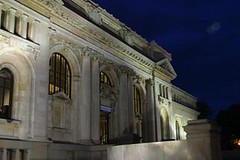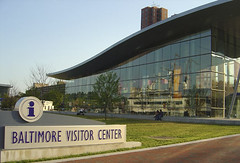From the archives: Who ♥ DC? -- More about DC tourism
 Carnegie Building on Mount Vernon Square. (Photo from www.dceventphoto.com)
Carnegie Building on Mount Vernon Square. (Photo from www.dceventphoto.com)----------------
This is reprinted from 7/29/2005, and comprises a set of emails from 2004, plus stuff written for the blog entry then. Since I have a meeting about this today, it's worth reprinting.
The issue, as discussed in this blog entry from earlier in the year, "Central Library Planning efforts and the City Museum, how about some learning from Augusta, Maine ... and Baltimore?," has multiple threads, what stories do we tell, how, where, and how do we fund it.
Plus, the Historical Society of Washington is getting back in gear--and last night had a well attended holiday reception and they did a great job with an exhibit featuring images from various HSW collections--they have determined that they have over 1 million images!
----------------
I think it would be worthwhile using this Post article ("City Museum on Shaky Ground: After 14 Months, Visitors and Cash Are in Short Supply") as a jumping off point for discussing some of the issues related to cultural tourism and DC, as a way for the cultural marketing-history-tourism community to get a better understanding of these issues, in hopes of making sound decisions that benefit our organizations and the community. I have some thoughts about this and I'll throw them out hoping others will chime in...
First, I think that the City Museum is a great concept but that the idea of cultural tourism in our neighborhoods is a tougher sell than people think. Most people come to the city with very fixed tourism ideas centered around the national experience (Capitol, Supreme Court, National Mall, and to a lesser extent visiting Alexandria and Georgetown, etc.) and the national centers of culture, specifically the Smithsonian Museums, and in particular the Air and Space Museum. "Market development," or teaching this market segment "new tricks" is very timec onsuming and expensive.
I think it would be very useful for all of us in the broad cultural marketing-museums-tourism-historic preservation communities to see some solid research that analyzes the various market segments of those that travel to DC on work or for leisure. Is anyone familiar with such published research? I have seen speeches about the importance of Washington as an international destination (by Bill Hanbury and J.W. Marriott). Now I believe this, but this was also a campaign of puffery designed to promote Washington for the 2012 Olympics.
Does WCTC or others conduct and release this research to the broader interest community? Does Cultural Tourism DC? Does the Smithsonian regularly publish and distribute their visitor statistics and surveys? (n.b. for data from the Smithsonian click here, for reports on the DC tourism market from WCTC, click here.) Does the National Park Service? I have seen figures in articles in the Washington Post, or recounted in speeches, but I have never seen such sent to this list for example.
n.b. The market for cultural heritage tourism is well defined and strong. Is DC doing the best job it can marketing to this segment? I'm not criticizing, I'm just asking. I see the results of the work by WCTC in articles such as about Eastern Market in the Baltimore Sun. In my opinion, Cultural Tourism DC is doing phenomenal work with the history trails and their broad project in Shaw/U Street which is a great model for those of us in other neighborhoods around the city.
Recently I have been exposed to the ideas of "local and national heritagea reas" (the ideas have been around for awhile) and it's a useful way for thinking about tapping into a region's cultural resources-assets, coordinating efforts, and marketing an area more broadly. This is the overall methodology that guides Cultural Tourism DC (although I think various efforts across the city aren't necessarily coordinated).
But I have learned that Baltimore, which has a designated local heritage area, as well as more than one state-designated arts district, has combined cultural efforts into the "Baltimore Office of Promotion and the Arts," which is a city agency. This agency actually mounts a number of the big street festivals in Baltimore including Artscape. (And they have the Baltimore Heritage Area .)
Second, speaking of market research, it should have been understood that most convention goers were unlikely consumers of the City Museum's offerings. Such visitors come to the city for a convention, be it FOSE etc., but unless it is a specific history-related convention, it is probably difficult to sell add-on neighborhood-based cultural tourism, especially with the limited time and money of convention goers and the fact that the local story has to compete with the "national story." In such situations, business-tourists are likely to go with the national stuff, and leave the local for another time. (The success of the City Museum with special events makes sense. Evening events in cultural facilities tend to be one of the big tie ins to conventions generally, even if people don't get out to many other local venues during their stay.)
Again, this isn't a criticism of the City Museum. The Phillips Collection and the Corcoran share the same issues vis-a-vis the Smithsonian museums -- "local vs. national," "pay vs. free." It would be useful to have a broader discussion about these organizations and their marketing strategies given their situation.
cf. Recent discussion of the broad TIF legislation to fund the expansion of the Corcoran. [Of course, this situation has changed significantly re the Corcoran. They've dropped their Gehry-designed expansion plans, and the director left.
cf./2, this interesting idea from Blake Gopnik on having the Corcoran focus on photograpy--"Memo to: The Corcoran Re: Sharpening Your Focus." Note that DCist disagrees, but I think they missed the point somewhat, this is an idea about focus and differentiation in an extremely competitive environment.)
Third, of course the gorilla in the room is the experience of the International Spy Musem, which is going gangbusters, charging a lot of moneyand having more than 700,000 visitors in their first year. Is the multimedia experience the way to go, are cultural experiences to be mediated (the underground Visitor Center for the U.S. Capitol that is under construction) rather than experienced directly (the U.S. Capitol)?
__________
There is a workshop conducted by the National Trust for Historic Preservation called "Great Tours." It focuses on house museums and historic sites, but really it's a methodology, a charrette if you will, on understanding your site, and developing the themes that lead to the best stories for explaining your collection and what your site has to offer.
Similarly, a few months back I attended an abbreviated "How to Turn a Place Around" workshop done by the Project for Public Spaces as a training for Scenic America state coordinators. Both experiences convinced me about the value of participation-workshops bringing together people with a wide variety of skill sets and experiences. I think charrettes are great, but without providing some "basic training" it's hard to achieve best practices and vision, unless the workshop conveners are committed to it.
The Great Tours workshop and handbook opened my eyes to the necessity of "selling" historic districts by focusing on the neighborhood themes and stories that place specific neighborhoods within the context of local, national, and even international history.
The PPS workshop demonstrated so clearly that a group of knowledgeable advocates, working through the PPS approach, can come up with plans and programs in short period of time that far exceed the results of commissioned "professional firm" plans. It's what Wright and Fung call "empowered deliberative democracy" in the book Deepening Democracy. (Lately I have been thinking that land use and development issues such as these are the locus for the most significant participation in the polity on the part of most citizens.)
I think there's something to be said for considering a public charrette for museum, heritage, preservation, tourism folks in the city, around the City Museum issue, and the role of cultural heritage in the civic life of the city, not just as an economic development tool. Focusing on DC's heritage, architecture, and history strictly as a tourism tool does, at some level, diminish the intrinsic value of history and heritage in our society.
The Trust could probably be induced to doing the Great Tours workshop in DC, although it would have to be reconfigured to deal specifically with theissues we need to grapple with, rather than the "academic exercise" of the fictitious Caleb Crawley House. In any case, knowing and celebrating this history is essential to the continued success and livability of Washington, DC "beyond the monuments."
__________________
Lately, I have pondering the Comprehensive Plan revision process and I am coming to the conclusion that it mixes up two very different thrusts, developing a strategic plan for the City of Washington and developing a plan to guide and direct land use and development. Granted that the two are inextricably linked, but I think failing to fully focus on either means that a lot gets missed.
The recent thread on the City Museum leads me to believe that there are two major holes in the "Strategic Plan" aspects for the City in the revision process as it relates to culture and arts:
(1) there is no section on "Arts and Cultural Development" in the Comprehensive Plan*;
(2) there probably should be a related section on "Tourism Development and Management."
Neither is included in the extant current Comprehensive Plan although Historic Preservation, which serves many objectives: economic development; tourism; neighborhood stabilization; housing; cultural development, etc., does have a section.
[* Now there is, but the adage, "Be careful what you wish for, because you might get it" is apt. Cultural people like it as a form of acknowledgement and recognition, but it isn't much of plan, in my opinion anyway)
Lately, the City Museum folks have been looking into these issues, and linking visitor services with narrative about the local Washington. The biggest problem perhaps with the Museum aspect is that people were so enamored with the location and the proximity to the Convention Center that they didn't look at the facility in terms of its support for museum functions. The building's too small, there are few galleries, and they can't accommodate various types of artifacts (such as vehicles), etc.
But there is something to be said for a Visitors Center-Museum combination. Baltimore gets the Visitor Center right. And with their new Heritage Trail, like DC's extant trails in places like Downtown, Southwest, and Capitol Hill, they actually run the tours from the Visitors Center. Imagine if the City Museum had been central as a staging point for heritage tours around the city of Washington.
 Baltimore Visitor Center. Lots of tourist information and printed materials, staff (and trained volunteer staff), and a film. The film needs work and needs to be listenable in languages other than English, at least for a DC version. And they need a diorama explaining Baltimore's public transit options. No history though, other than brochures.
Baltimore Visitor Center. Lots of tourist information and printed materials, staff (and trained volunteer staff), and a film. The film needs work and needs to be listenable in languages other than English, at least for a DC version. And they need a diorama explaining Baltimore's public transit options. No history though, other than brochures.Index Keywords: cultural-heritage-tourism



0 Comments:
Post a Comment
<< Home